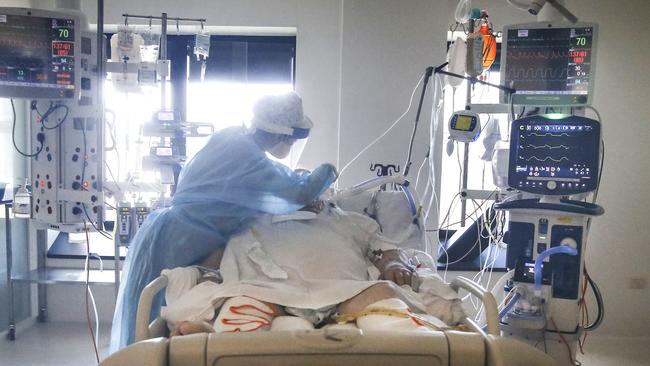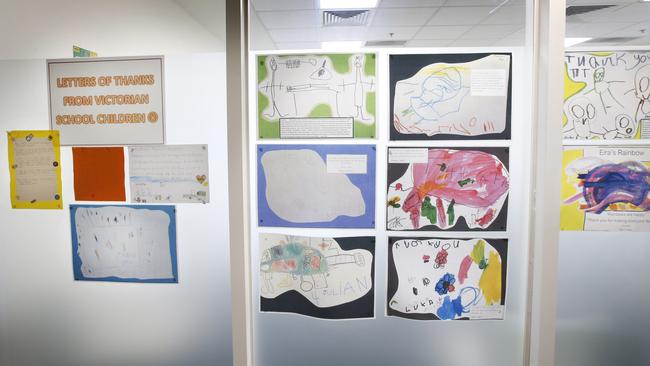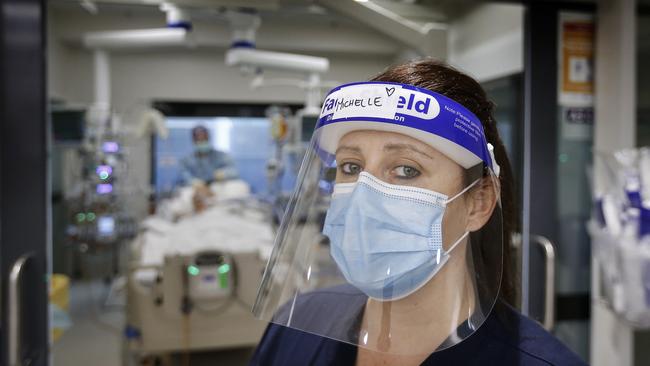Coronavirus survivors face a long road ahead
While lucky to be alive, coronavirus patients leaving intensive care have, as one veteran nurse puts it, “years of hard slog” ahead. This is what the Herald Sun witnessed behind the scenes of a COVID-19 ward.
Coronavirus
Don't miss out on the headlines from Coronavirus. Followed categories will be added to My News.
The COVID-19 patients who make it out of intensive care will face years of life-altering obstacles.
So too will the medical staff who helped them survive.
Coronavirus is like nothing they have had to cope with before.
Experienced intensive care specialists usually have a very good idea of whether a patient is going to survive as they arrive in the Royal Melbourne Hospital’s sixth-floor ICU, and set their care and family’s expectations accordingly.
COVID-19 is different.
Whereas the average length of stay in RMH’s ICU is 72 hours, those with coronavirus are here for more than 20 days, many of them on life support.
“I have been here 23 years and I have never seen anything like it,” Unit Manager Michelle Spence said.
“They come in really sick and, once we put them on life-support, there is a little bit of stability.
“It is a tiny step forward and three steps back every day.
“Some of these patients that are here now with COVID have been here for 25–30 days.
“It is pretty ugly – for these patients it is pretty tough going.”

Not only is the condition of COVID-19 patients proving unique to cope with, the number of overall infections and subsequent patients have also sent shivers up the spines of ICU workers each day.
Since the start of July there have been 26 COVID-19 patients in the RMH’s ICU.
Others have been transferred to other intensive care units in recent weeks under “clustering” arrangements of the pandemic plan painstakingly drawn up earlier this year.
The plan also saw the RMH open an entirely new ICU now known “D Pod” – matching the sixth floor’s existing A, B and C Pods – lifting the number of medicine’s most specialised beds from 32 to 42.
So far the expanded ICU has not reached capacity, but Ms Spence said transfers have been handled in a “textbook” way to free up room, knowing they could have a sudden rush of critical patients from the hospitals’ COVID wards at any moment.
But there is no textbook for what faces patients surviving ICU.

“They are leaving here and they have got no muscle, they can’t do anything for themselves, they are going to the ward needing full care – they are going to have to learn to do everything again,” Ms Spence said.
“They are all bed bound, they are not walking, a lot of them have a tracheostomy so they can’t talk, but they are awake … it will be a really hard slog.
“What were you seeing here, there is going to be years of hard slog.”
Only one COVID-19 patient was in the RMH intensive care unit when the Herald Sun visited on April 16, although there had been three over the preceding weeks of the first wave.
When the Herald Sun returned on Thursday there were seven patients in the unit’s dedicated COVID pod, as well as another two in other sealed rooms throughout the ICU.
For the first few months of the year Ms Spence led the effort to find and train another 200 nurses from other areas of the hospital in case coronavirus’ full force hit.
She was thrilled when Victoria’s infections dropped in April, and her efforts appeared redundant – only to watch daily numbers rise from June, desperately hoping for Stage Four lockdown to ease the carnage few outside the hospitals see.

By far the biggest issue affecting staff is the fact they can’t let families visit desperately ill loved ones.
When a patient is in their final hours the hospital is allowing one or two family members to visit for a heartbreaking goodbye, but the human toll is something all will carry for years to come.
“It was a kind of denial where we were in the first stage three down, the patient numbers weren’t really there, we were kinda like ‘oh we can relax’,” Ms Spence said.
“We have now had a peak.
“Over the last few weeks we have seen about 20 COVID patients – it is a really slow process.
“It is taking a toll on staff.
“I had somebody in my office crying this morning because this is just not right.
“Then they have to find the energy to come to work, and everyone is doing long hours and is fatigued.
“But everyone is doing their job, that is what they train for.”
MORE NEWS
WE HAVE HELD SO MANY AS THEY DIE
HOW WE WILL BE WEARING FACE MASKS INTO 2021
